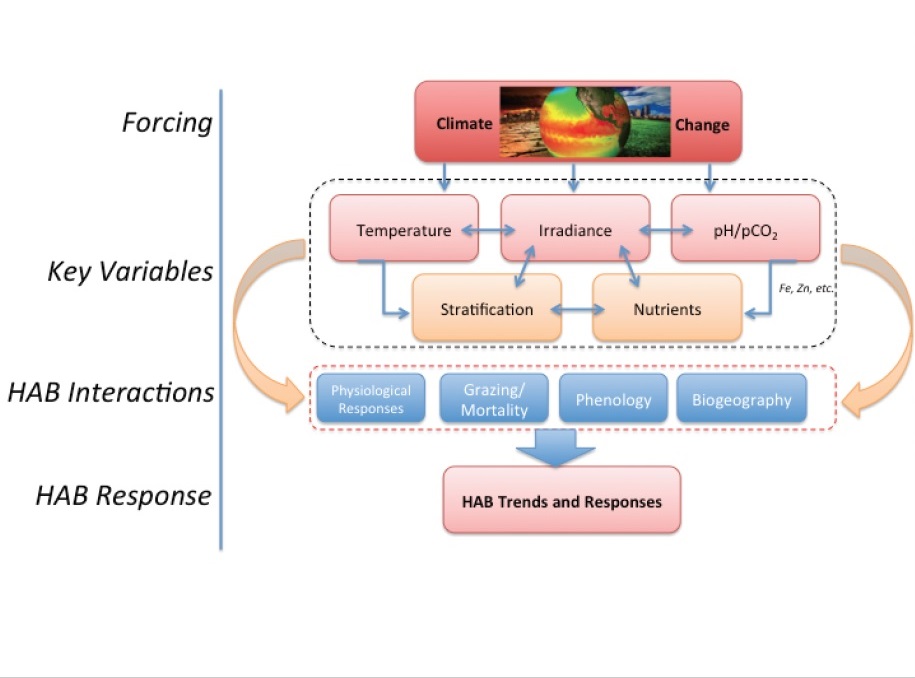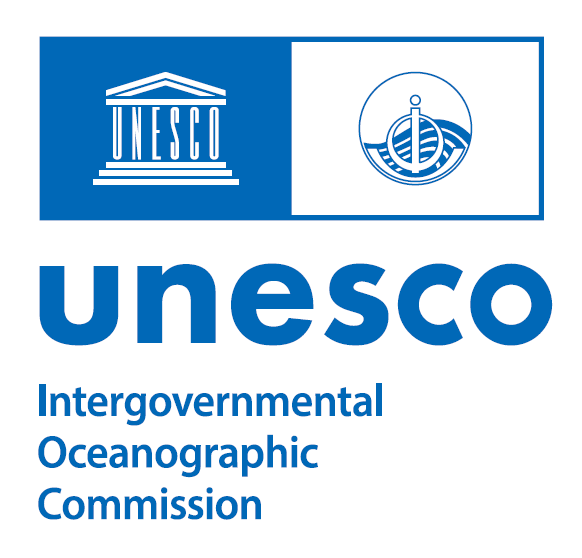Overall objective: To understand global patterns in HAB responses to common drivers (thermal windows, stratification, changing levels of CO2).
Rationale. Although not explicitly discussed in the GEOHAB Science Plan (GEOHAB 2001) when the programme was launched, the potential impacts of climate change on HAB dynamics was noted. Indeed, “long-term climatic changes” was already mentioned as a driver of increased HABs. Furthermore, the effects of climate change were highlighted in some specific areas of GEOHAB concerning the Programme Elements “Biogeography and Biodiversity” and “Observation, Modeling and Prediction”.
There is increasing concern that global change may stimulate geographic expansion and increases in severe impacts of HABs (e.g., Hallegraeff 2010, Wells et al. 2015). There is ample evidence that the main drivers of the general dynamics of microalgae (surface water temperature, ocean stratification, wind and water circulation patterns, precipitation-linked nutrient inputs, but also changes such as salinization of estuaries which may lead to expansion of marine HABs) are changing in ways that could stimulate more HABs. Further anthropogenic pressures on aquatic ecosystems include surface water acidification derived from increasing CO2 emissions and alteration of natural habitats, especially in the coastal zones.
Forecasting the future occurrence of HABs requires continuing our efforts to improve the fundamental knowledge of the mechanisms driving these events, as identified in GEOHAB. A fundamental question is whether the environmental windows of opportunity for HAB species are expanding, or simply shifting geographically and/or seasonally. It is necessary to investigate the responses of the harmful microalgae (including toxin production) not only in relation to individual natural drivers (i.e., temperature, salinity, nutrients, CO2) but also to changes in the interactions among them. For instance, in cold fjords regions (Chile, Norway) high runoff due to increased snow melting may modify water stratification and mixing dynamics. The indirect effect of temperature on salinity may have consequences on the occurrence of certain HAB events in these and other areas. Shellfish exposed to new HAB species to which they were not adapted, will be very vulnerable. This situation was already hypothesized by Bricelj et al. (2005), later validated during the Alexandrium catenella bloom in 2016 described in Hernández et al. (2016) and its effect in mass mortality of clams (Álvarez et al. 2017).
The particular impact of ocean acidification on HABs requires special attention, because the knowledge is just developing and the experimental approaches are not clearly established yet. Indeed, although CO2 levels are rising, they also fluctuate diurnally and undergo a large seasonal cycle. In coastal systems, the daily (24 hours) change in CO2 can be larger than the projected change in the coming century. Further, highly eutrophic systems (which are prone to HABs) can experience CO2 levels exceeding levels projected for open oceans for 300 years from now. The key fact is that CO2, an important driver for coastal microalgal communities, is rising and it is dynamic in coastal systems. Long-term studies are needed, including effects of CO2 on algal population dynamics in general, but also related to CO2 effects on different harmful species.
Finally, forecasting requires consistent and long-term data series.

The progression of climate change pressure on key variables and related HAB interactions that will drive HAB responses in the future ocean. From Wells et al. (2015), with permission from the journal.
Specific Objectives
- Understand global and regional patterns in HAB responses to the most common identified drivers (thermal windows, stratification, changing levels of CO2).
- Encourage and facilitate the use of data from the “natural laboratory”, that is, long time series on weather, physical and chemical parameters and HAB occurrence, as a base for predictions of climate effects on HABs.
- Encourage experimental work on climate effects on HABs, for example, laboratory and mesocosm
- experiments, as a base for predictions of climate effects on HABs.
- Support an expansion of the number of comprehensive, region-specific studies integrating biological process data with downscaled climate projections.
- Encourage the adoption of best practices in lab and field approaches to investigate HAB responses to climate-linked drivers (see Wells et al. 2015).
- Create synergies with other international groups to investigate ocean deoxygenation in response to climate change and eutrophication, with a specific focus on HABs.
- Explore the use of paleoceanographic records to understand HAB variability in response to past climate events.
Example tasks
- Coordination with other international bodies that share interest in the modulation of HABs by climate change, including GOOS, GODAE MEAP-TT, GO2NE, GEO/BluePlanet, IPCC.
- In coordination with GOOS, contribute to the development of HABs as part of the “Phytoplankton EOV” (Essential Ocean Variable) by completing a list of existing time-series locations, and identifying super-sites for time-series observations of HABs and related oceanographic parameters to track the potential impact of climate change on HABs.
- Convene an open modeling workshop focused on aligning existing time-series observations with existing climate hindcasts and projections (e.g., GODAE MEAP-TT).
- Produce a best-practices manual for HAB and climate change research, coordinated with IOC updates, including definition of procedures to collect and store data concerning species distribution and what reference information is needed in order to provide standardized information (genetic characterization, etc.).
- Coordinate a global-scale analysis of responses to common drivers in an ensemble of existing projections, with the lists of HAB case studies, models, and participants growing out of modeling workshop above.
- Hold training workshop or summer school for junior scientists, on the theme of improving communication among biologists, biological modelers, and ocean/climate modelers, in pursuit of a mechanistic understanding of diverse responses to climate-driven variables in key taxa.
- Support new culturing experiments to fill physiological information gaps (as noticed in the Theme 2. Adaptive strategies).
- Support the development of new model approaches, and the application of existing trait-based phytoplankton models to HABs (as noted in the Theme 8. Observation, Modelling and Prediction).
- Encourage the incorporation of genomic information on trait regulation and the molecular basis of observed population-level changes into monitoring and modeling (as noted in Theme 1. Biodiversity and Biogeography).
Outcomes
- Comprehensive understanding of the global and regional patterns in HABs under different climate change scenarios.
- Best practices manual to investigate the responses of HAB species and future trends in HABs under different climate change scenarios
- INFORMATION FOR POLICY MAKERS: Credible, high-level outlook on HABs included in IPCC reports.
References
The complete list of references can be found here.


